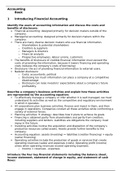Samenvatting
Accounting samenvatting boek deeltentamen 1
- Vak
- Accounting
- Instelling
- Erasmus Universiteit Rotterdam (EUR)
Samenvatting van het boek voor het eerste deeltentamen voor Accounting, blok 2 Bachelor jaar 1Bedrijfskunde. Kan ook voor IBA gebruikt worden (is in het Engels)
[Meer zien]





